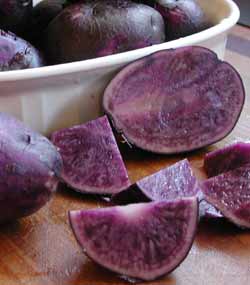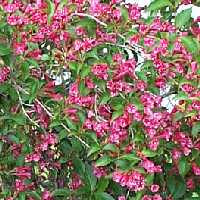 Weigela Do you know the name of this rarer variety with the darker coloring? Let me know - [email protected] Family: Caprifoliaceae A decidious shrub growing to 5m. It is hardy to zone 6. It is in flower from May to June. The flowers are hermaphrodite (have both male and female organs). The plant prefers light (sandy), medium (loamy) and heavy (clay) soils and requires well-drained soil. The plant prefers acid, neutral and basic (alkaline) soils. It can grow in semi-shade (light woodland) or no shade. It requires moist soil. It can tolerate atmospheric pollution. |
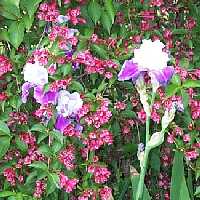 Purple Bearded Irises Family: Iridaceae Iris means "rainbow" in Greek In some languages, irises are called flags or sword flags, relating them to symbols of heraldry and royalty, hence the original "Fleur de lys" of heraldry. In Japan the shape is seen to express heroism and the blue colour refers to blue blood, so irises play a key role in their spring festival for boys. Perennial growing to 0.6m by 1m . It is hardy to zone 6 and is not frost tender. It is in flower in June, and the seeds ripen from August to September. The flowers are hermaphrodite (have both male and female organs) and are pollinated by Insects. The plant is self-fertile. The plant prefers light (sandy) and medium (loamy) soils, requires well-drained soil and can grow in heavy clay soil. The plant prefers acid, neutral and basic (alkaline) soils. It can grow in semi-shade (light woodland) or no shade. It requires moist soil. |
 Stargazer Lily Oriental Lily Lilies have been cultivated for over 3000 years. Feng Shui believers hold the lily as an emblem of summer and abundance; to the Chinese, lily means "Forever in love". |
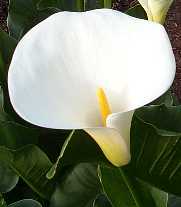 Calla Lily Zantedeschia aethiopica Family: Araceae A native of South Africa Many plants in this family are poisonous raw, due to the presence of calcium oxylate crystals. If eaten raw, this toxin gives you a sensation as if hundreds of tiny needles are sticking into the mouth, tongue etc. However, it is easily destroyed by thoroughly cooking or drying the plant. Although no specific mention has been seen for this plant it is wise to assume that it is poisonous in its raw state. An evergreen perennial growing to 1m by 0.6m at a medium rate. It is hardy to zone 8 and is frost tender. It is in leaf all year, in flower from July to November. The flowers are monoecious (individual flowers are either male or female, but both sexes can be found on the same plant). The plant prefers light (sandy), medium (loamy) and heavy (clay) soils. The plant prefers acid, neutral and basic (alkaline) soils. It can grow in semi-shade (light woodland) or no shade. It requires wet soil and can grow in water. |
 Rhododendron Family: Ericaceae Spring flowering, evergreen |
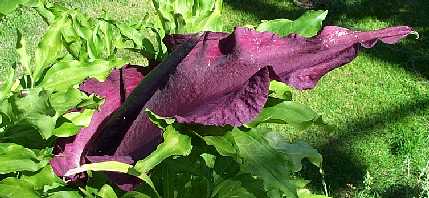 Dracunculus vulgaris A June flowering bulb, with the aroma of rotting flesh Pleasantly gothic and sinister |
 Firepoker Family: Asphodelaceae Kniphofia are native to South Africa. Named after German physician J H Kniphof. An evergreen perennial growing to 2m by 1m . It is hardy to zone 5. It is in leaf all year, in flower from August to September. The flowers are hermaphrodite (have both male and female organs). It is noted for attracting wildlife. The plant prefers light (sandy) and medium (loamy) soils. The plant prefers acid, neutral and basic (alkaline) soils. It cannot grow in the shade. It requires moist soil. The plant can tolerate maritime exposure. |
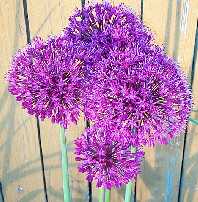 Allium giganteum Family: Alliaceae Bulb growing to 2m by 0.15m . It is hardy to zone 8. It is in flower in May. The flowers are hermaphrodite (have both male and female organs) and are pollinated by Bees and insects. The plant prefers light (sandy) and medium (loamy) soils and requires well-drained soil. The plant prefers acid, neutral and basic (alkaline) soils. It cannot grow in the shade. It requires dry or moist soil. |
 Staghorn Sumac Rhus typhina (non-poisonous) Family: Anacardiaceae The leaves are alternate and pinate and the fruit is borne as a dense cluster of deep crimson dry berries at the top of the tree. The fruits ripen in the fall and persist throughout the winter. It has an irregular open and flat crown. A decidious shrub growing to 6m by 6m at a fast rate. It is hardy to zone 3 and is frost tender. It is in flower from June to August, and the seeds ripen from October to December. The flowers are dioecious (individual flowers are either male or female, but only one sex is to be found on any one plant so both male and female plants must be grown if seed is required) and are pollinated by Bees. The plant not is self-fertile. The plant prefers light (sandy), medium (loamy) and heavy (clay) soils, requires well-drained soil and can grow in nutritionally poor soil. The plant prefers acid, neutral and basic (alkaline) soils. It cannot grow in the shade. It requires dry or moist soil and can tolerate drought. The plant can tolerates strong winds but not maritime exposure. |
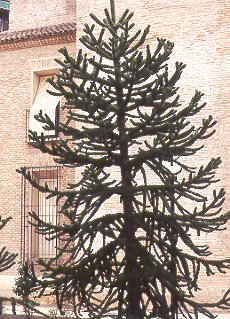 Monkey Puzzle tree Araucaria araucana Family: Araucariaceae An evergreen tree growing to 30m by 15m at a slow rate. It is hardy to zone 8 and is not frost tender. It is in leaf all year, in flower from June to July, and the seeds ripen from September to October. The flowers are dioecious (individual flowers are either male or female, but only one sex is to be found on any one plant so both male and female plants must be grown if seed is required) and are pollinated by Wind. The plant not is self-fertile. The plant prefers light (sandy), medium (loamy) and heavy (clay) soils and requires well-drained soil. The plant prefers acid, neutral and basic (alkaline) soils. It can grow in semi-shade (light woodland) or no shade. It requires moist soil. The plant can tolerate maritime exposure. |
 Anemone Familae: Ranunculaceae The genus, Anemone, the name of which is derived from the Greek word for 'wind' (anemos), includes about 65 species. Many of these species have corms, others have rhizomes, while others are ordinary perennial plants. I have the type which blooms in late winter or early Spring. |
 Aquilegia caerulea (columbine) Perennial growing to 2 feet, hardy to zone 3. It is in flower from April to July. The flowers are hermaphrodite (have both male and female organs) and are pollinated by Bees. The plant prefers light (sandy) and medium (loamy) soils and requires well-drained soil. The plant prefers acid, neutral and basic (alkaline) soils. It can grow in semi-shade (light woodland) or no shade. It requires moist soil. |
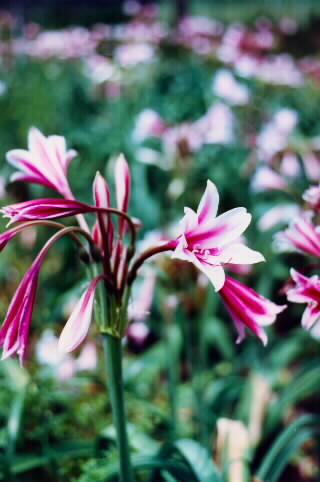 Crinum Family: Liliaceae Bulb growing to 3 feet, hardy to zone 6. It is in flower from June to August. The scented flowers are hermaphrodite (have both male and female organs) and are pollinated by Insects The plant prefers light (sandy) and medium (loamy) soils and requires well-drained soil. The plant prefers acid, neutral and basic (alkaline) soils. It cannot grow in the shade. It requires moist soil. |
 Amaryllis Family: Amaryllidaceae |
 Heuchera Family: Saxifragaceae They like part to full sun with well drained soil. Hardy from zones 4 to 8, they are evergreen in all but the coldest parts of their growing zones, where a light winter mulch is beneficial. |
 Crocosmia Family: Iridaceae Corm growing 2 to 3 feet at a fast rate. It is hardy to zone 7. It is in flower from July to August. The scented flowers are hermaphrodite (have both male and female organs) and are pollinated by Insects. The plant prefers light (sandy) and medium (loamy) soils. The plant prefers acid, neutral and basic (alkaline) soils. It can grow in semi-shade (light woodland) or no shade. It requires moist soil. |
 Hellebore Family: Ranunculaceae An evergreen perennial growing to 1 foot . It is hardy to zone 3 and is not frost tender. It is in leaf all year, in flower from January to February, and the seeds ripen from May to June. The flowers are hermaphrodite (have both male and female organs) and are pollinated by Bees and flies. The plant prefers light (sandy), medium (loamy) and heavy (clay) soils and can grow in heavy clay soil. The plant prefers acid, neutral and basic (alkaline) soils. It can grow in semi-shade (light woodland). It requires moist soil. |
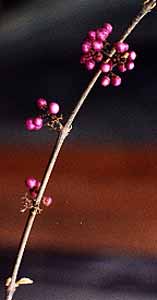 Profusion beautyberry, callicarpa bodinieri Family: Verbenaceae A decidious shrub growing 3 to 6 feet at a slow rate. It is hardy to zone 6. It is in flower from June to July. The flowers are hermaphrodite (have both male and female organs). The plant prefers medium (loamy) soils and requires well-drained soil. The plant prefers acid, neutral and basic (alkaline) soils. It can grow in semi-shade (light woodland) or no shade. It requires moist soil. |
 Heliotropium arborescens - Heliotrope Family: Boraginaceae An evergreen shrub growing to 1m by 1m . It is hardy to zone 10 and is frost tender. It is in leaf all year, in flower from May to September. The scented flowers are hermaphrodite (have both male and female organs) and are pollinated by Bees and Lepidoptera (Moths & Butterflies). It is noted for attracting wildlife. The plant prefers light (sandy), medium (loamy) and heavy (clay) soils and requires well-drained soil. The plant prefers acid, neutral and basic (alkaline) soils. It cannot grow in the shade. It requires moist soil. |
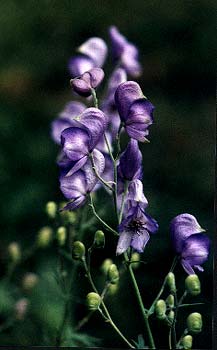 Aconitum napellus - Monkshood Family: Ranunculaceae Perennial growing to 1.5m by 0.3m . It is hardy to zone 3. It is in flower from August to September. The flowers are hermaphrodite (have both male and female organs) and are pollinated by Bees. The plant prefers light (sandy), medium (loamy) and heavy (clay) soils and can grow in heavy clay soil. The plant prefers acid, neutral and basic (alkaline) soils. It can grow in semi-shade (light woodland) or no shade. It requires moist soil. |
 Abutilon megapotamicum Family: Malvaceae An evergreen shrub growing to 2m by 2m . It is hardy to zone 8. It is in leaf all year, in flower from April to September. The flowers are hermaphrodite (have both male and female organs). The plant prefers light (sandy), medium (loamy) and heavy (clay) soils. The plant prefers acid, neutral and basic (alkaline) soils. It can grow in semi-shade (light woodland) or no shade. It requires moist soil. |
 Cornus Kousa angustifolia Family: Cornaceae A decidious tree growing to 10m by 6m at a slow rate. It is hardy to zone 5. It is in flower in June, and the seeds ripen in September. The flowers are hermaphrodite (have both male and female organs) and are pollinated by Insects. The plant prefers light (sandy), medium (loamy) and heavy (clay) soils and can grow in heavy clay soil. The plant prefers acid, neutral and basic (alkaline) soils. It can grow in semi-shade (light woodland) or no shade. It requires moist soil. |
 Ipomoea batatas - Tricolor ivy, sweet potato vine |
 Houttuynia cordata, variegated Family: Saururaceae Perennial growing to 0.6m by 1m at a fast rate. It is hardy to zone 5 and is frost tender. It is in flower in June. The scented flowers are hermaphrodite (have both male and female organs). The plant prefers light (sandy), medium (loamy) and heavy (clay) soils. The plant prefers acid, neutral and basic (alkaline) soils. It can grow in full shade (deep woodland) or semi-shade (light woodland). It requires moist or wet soil and can grow in water. I have mine in a pot sitting in my fountain/stream |
 Passiflora, Passion Flower Family: Passifloraceae An evergreen climber growing to 10m by 10m at a fast rate. It is hardy to zone 7 and is frost tender. It is in leaf all year, in flower from June to September, and the seeds ripen from September to November. The scented flowers are hermaphrodite (have both male and female organs) and are pollinated by Bees. The plant prefers light (sandy), medium (loamy) and heavy (clay) soils and requires well-drained soil. The plant prefers acid, neutral and basic (alkaline) soils. It cannot grow in the shade. It requires moist soil. |
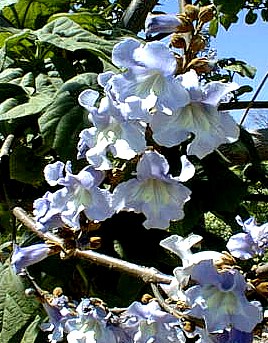 Paulownia tomentosa Family: Scrophulariaceae The Empress Tree - A decidious tree growing to 45 feet by 30 feet at a fast rate. It is hardy to zone 5 and is frost tender. It flowers in May after it is 5-7 years old. The scented flowers are hermaphrodite (have both male and female organs). The plant is self-fertile. It needs full sun and moist but well drained soil. It can tolerate atmospheric pollution. Leaves are large, broadly oval to heart-shaped, or sometimes shallowly three-lobed, and noticeably hairy on the lower leaf surfaces. They are arranged in pairs along the stem. Conspicuous upright clusters of showy, pale violet, fragrant flowers open in the spring. The fruit is a dry brown capsule with four compartments that may contain several thousand tiny winged seeds. Capsules mature in autumn when they open to release the seeds and then remain attached all winter, providing a handy identification aid. In the Chinese tradition, parents planted a Paulownia tomentosa when a daughter was born. As the girl reached the 'marrying age', the mature tree was cut down to make all sorts of handsome household items for her dowry. This charming tradition also underscores the quick growth of this interesting species. NPS Virginia Tech Mediterranean Garden Society Dave's Garden Vanderbilt NC State |
BBB |
CCC |



